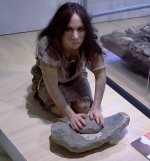I don't know. During and right after LGM European HG were mobile reindeer hunters. They were following their prey on thier journeys between summer and winter pastures.
Then the forests started to grow and along came the Villabrunans who conquered large parts of Europe. Once they found an intersting spot they settled down. Their prey wasn't so mobile either and fishing and gathering (done by the women?) became an important supplement to their diet.
The drowning of Doggerland must have caused overpopulation in areas like the southern Baltic where many tribes lived very close to each with their onw rituals but without intermingling. In fact they were probably at war with each other most of the time, very frequently quareling over territories and women.
I've always had the impression the EHG remained somewhat more mobile, moving up and down streams and lakes with canoes.
Lepenski Vir is a very intersting story and I am glad we finally have some DNA now, but it will take some time for me to digest.
Megalithism was already in Evora, Portugal 8 ka, before the arival of the first cardial ware farmers. In Brittany it emerged in HG territory ca 6.9 ka , but these HG probably already had contacts with LBK farmers further inland. Both areas were quite densely populated by HG, relying heavily on sea food.
In southern Portugal, new cardial ware settlements emerged 7.4-7 ka and the HG sea food settlements seem to slowly dissapear, as if the HG population becomes extinct. That is what archeologists taught, but now DNA proves them wrong.
Megalithic people became farmers, but if you check, they have a very high percentage of I2 versus G2a and a very high percentage of U5 versus farmers mtDNA.
Apart from an initial move from the LBK and Swifterbant area in eastern England, the British Isles were colonised by megalithic farmers.
Later megalithism also spread more inland with Michelsberg culture and north to the southern Baltic into the late TRB culture.
But megalithism is just something on the western fringes of Europe.
Also in central Europe there was a resurgence of haplo I2.
I have no clue how this came about.
We have the story of the Blatterhöhle HG who remained fisher HG for almost 2000 years next to the incoming farmers.
Swifterbant is another story, it is in the western Netherlands, you should check these guys too. It is about HG coming into contact with the LBK further inland and through trade creating a new, very diversified economy. We should get their DNA, but I guess it will be hard to find in these soils.
I can't cite big papers, I'm just telling you some impressions I get after reading little things here and there.
When I'll check and digest these new papers further, I'm sure more stories will start to grow in my head.
P.S. I think women were very often regarded as just servant slaves by both farmers and HG.
How about this pic :
it reminds me of the findings in the Catal Hoyuk graveyard, as well as in Abu Huryera, with old males and young females with wornout joints, probably from hard labour, something I brought up elsewhere
Catal Hoyuk was nevertheless seen as a matriarchal society, with the fertile mother earth as goddess
https://en.wikipedia.org/wiki/Çatalhöyük





